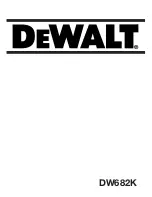
4
3. Set the biscuit depth selector to correspond with the
size of biscuit you are using. Generally #20 biscuits
suit most applications. If you are using stock that is 16
mm thick or less, you will need smaller biscuits.
4. Adjust the height of the fence as required and if using
the
fi
xed fence,
fi
rmly tighten the height lock knob
using
fi
nger pressure only. If using the adjustable
fence,
fi
rmly tighten the angle lock knob.
5. Place one hand on the handle and the other hand on
the motor housing.
6. Place the cutting guide at the center point of each slot
in turn and press the fence against the edge of the
workpiece. Make sure the joiner fence is
fl
ush with
both sides of your work surface.
7. Switch on the power switch and push the motor
housing towards the work material. Once the cut
is made, pull the motor housing back and allow the
return spring to retract the blade from the slot. Turn the
power switch off. Repeat the procedure until all slots
are cut in your workpiece.
8. Cut the slots in the matching piece of work material,
lining up the center point of each slot to make the cuts.
9. Once all the cuts are complete, dry
fi
t your biscuits into
your joins and test
fi
t your materials to ensure proper
alignment.
10. Remove the biscuits and insert glue into the slots
using a nozzle applicator or thin wood scrap. It is also
helpful to apply a small amount of glue on the biscuits
before inserting them into the slot.
11. Place the biscuits in position and clamp your work
materials together until the join line becomes invisible.
Keep your work materials clamped until the biscuits
swell and the glue sets.
It is possible that thick pieces of timber may require two
biscuits at each location, one at a height of about 1/3
the thickness of the wood, and the other at about 2/3 the
thickness.
NOTE:
Unlike other saws and drills, mastering the biscuit
joiner should take some practice. Remember that the
ultimate goal is to achieve a parallel set of cuts in your
work surface. If you
fi
nd yourself making uneven cuts, you
are probably working too fast. Take note of these points:
When the tool powers on, it might vibrate out of
position. Prior to making a cut, make sure the center
of the tool is aligned with the center of your cut mark.
Make sure the height lock knob is firmly tightened.
Go slow. Visually make sure you have the joiner lined
up with your cut mark and most importantly that the
fence is flush with both the top and side edges of your
work material prior to making the cut. Once these are
accomplished, make the cut. Patience and practice
are the keys to creating perfect joins.
MAINTENANCE
REPLACING THE BLADE
See Figure 8 - 9.
1. Pull out the power plug.
2. Remove the
fi
xed fence and raise the adjustable fence
to the 0 degree position.
3. Turn the machine over and unscrew the two screws in
the base plate. Pivot the base plate open.
4. With the arbor lock on the top of the gearbox housing
depressed, rotate the blade by hand until the blade
locks.
5. Loosen the blade
fl
ange anti-clockwise using the pin
wrench supplied.
6. Remove the outer blade
fl
ange.
7. Remove the blade leaving the inner
fl
ange in place.
8. Mount the new blade, insert the outer blade
fl
ange and
fasten.
IMPORTANT
The cutting bevel of the teeth (i.e. the direction of
rotation of the saw blade) has to conform to the direction
of the arrow marked on the housing.
9. Make sure the blade lock is released.
IMPORTANT
After replacing the blade, make sure the blade runs
freely by turning the saw head by hand.
10. Close the base and re-install the two screws.
11. Before using the machine again, check that the safety
devices are in good working order.
12. Plug the machine into a main socket outlet and run
the machine without actually cutting any work material.
This is to make sure the blade is spinning freely.
DUST EXTRACTION
See Figure 10.
You can use the dust bag provided or with the aid of
the adaptor accessory, connect the tool to a vacuum
system.
The plastic dust extraction assembly fits in the dust
port on the joiner. You can attach a vacuum hose or
the supplied dust bag to the adaptor.
When the bag becomes full, the dust will back-up into
the adaptor and the dust port. To clean them, turn off
and unplug the tool and remove the packed dust.
Keep the machine's air vents unclogged and clean
at all times. Remove dust and dirt regularly from the
machine. Cleaning is best done with compressed air
or a rag. Re-lubricate all exposed moving parts at
regular intervals.













